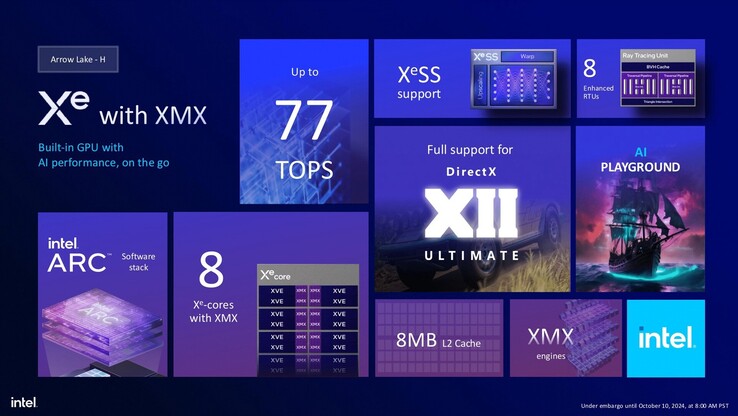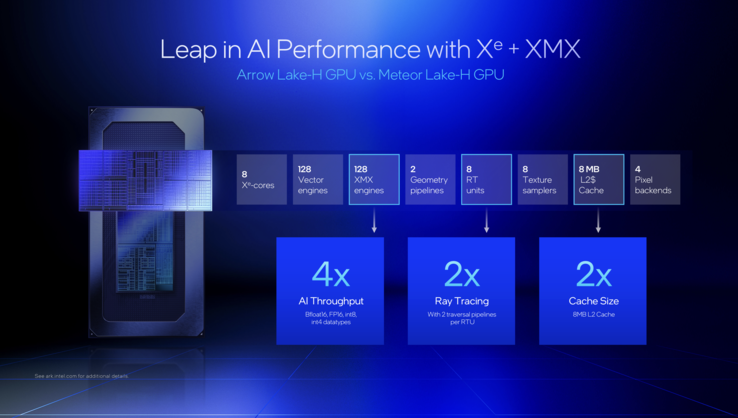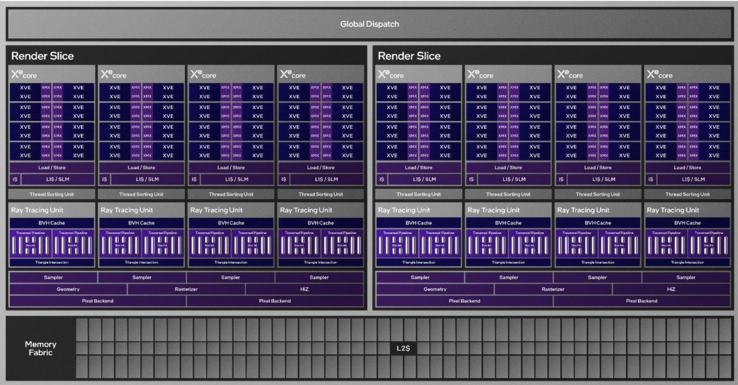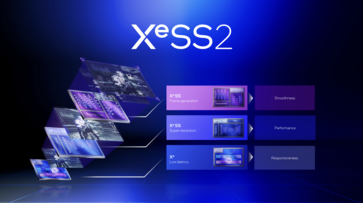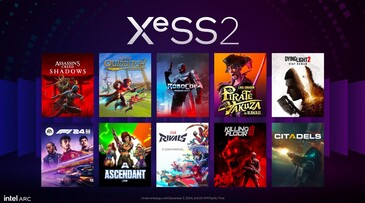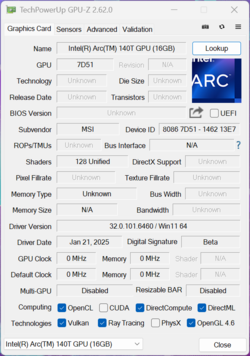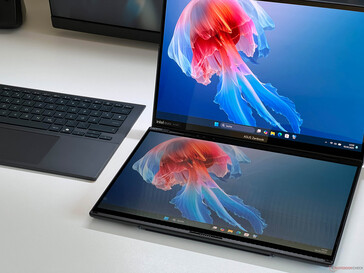Intel Arc Graphics 140T analysis – Arrow Lake-H iGPU gains frame generation support
Intel has just launched its latest Arrow Lake mobile processors (Core Ultra 200 series), and we’ve already had the opportunity to put the H-series CPUs through a detailed test. Alongside the CPU improvements, the integrated Arc Graphics 140T and Arc Graphics 130T have received a significant upgrade.
In this article, we analyze the technology and performance of these new iGPUs, comparing them to Intel’s own Lunar Lake graphics, AMD’s Zen 5 iGPUs, and the latest ARM GPUs from Apple and Qualcomm.
Overview - Intel Arc Graphics 140T
The two new integrated graphics solutions, Intel Arc Graphics 140T and 130T, are technically quite different from the Lunar Lake iGPUs (Arc Graphics 140V/130V). While Lunar Lake GPUs feature second-generation XeSS cores, the Arrow Lake iGPUs are enhanced versions of the Arc Graphics from the Meteor Lake generation. They still utilize first-generation Xe cores, but with notable improvements.
Like the Lunar Lake iGPUs, the new Arc Graphics 140T and 130T now incorporate XMX engines, significantly boosting AI performance to 77 TOPS. Additionally, ray tracing capabilities have been doubled, with the number of ray tracing units increasing to 8, and the L2 cache expanding to 8 MB.
Each Xe core still features 16 Xe vector engines and maintains full support for DirectX 12 Ultimate, including hardware-accelerated ray tracing and mesh shading.
At the end of last year, Intel introduced the second generation of its Xe Super Sampling (XeSS) technology, which now includes several new features. These enhancements include Super Resolution (XeSS-SR), Frame Generation (XeSS-FG), and Low Latency (XeLL).
Currently, all games that support XeSS 2—though still limited in number—fully integrate all three of these new features.
The new Arrow Lake-H GPUs fully support XeSS 2, including all its features, but the same applies to Lunar Lake models. Older iGPUs also offer XeSS 2 support, though not all features are available on those architectures.
The following table provides an overview of different GPU generations and their respective XeSS 2 capabilities.
| Chip Generation | XeSS Super Resolution | XeSS Frame Generation | Xe Low Latency |
|---|---|---|---|
| Lunar Lake/Arrow Lake-H | Yes | Yes | Yes |
| Meteor Lake/Arrow Lake-S | Yes | No | Yes |
| Tiger Lake/Alder Lake/Raptor Lake | Yes | No | No |
Test systems - Asus and MSI deliver the first models
The two test notebooks are the Asus Zenbook Duo and the MSI Prestige 16 AI, both equipped with the Core Ultra 9 285H and the fastest version of the Intel Arc Graphics 140T.
These devices feature different power implementations, affecting performance. In the Zenbook Duo, the processor peaks at 60 watts but stabilizes at 24 watts under sustained load. In contrast, the Prestige 16 briefly reaches 115 watts before quickly settling at 45 watts.
Both laptops are equipped with 32GB of LPDDR5x RAM (7467 or 7500 MHz), and the maximum core clock of the Arc Graphics 140T is 2.25 GHz.
We will also be adding benchmark results for the Arc Graphics 130T soon.
Test procedure
To ensure a meaningful comparison between the different graphics cards, we analyze power consumption alongside synthetic benchmark performance to determine overall efficiency.
All power consumption measurements are conducted using an external device to eliminate variations caused by internal factors. However, we measure total system consumption, not just raw TDP values, to provide a more comprehensive performance assessment.
GPU performance
Now, let's move on to performance, starting with synthetic benchmarks. It is clear that the Arc Graphics 140T performs at a level similar to high-end implementations of the Lunar Lake Arc Graphics 140V, occasionally holding a slight advantage. Intel claims a 20% performance improvement over the Meteor Lake Arc Graphics, and our tests confirm this on average.
This means the Arc Graphics 140T outperforms AMD’s Radeon 880M and Radeon 890M iGPUs. However, dedicated GPUs such as the GeForce RTX 3050 Ti, GeForce RTX 4050 Laptop, and Radeon RX 6550M still hold a clear performance advantage.
For ARM GPU comparisons, we focus on Steel Nomad tests in 3DMark, as they run natively on ARM systems. The Arc Graphics 140T is 40-50% faster than the Adreno X1-85 (4.6 TFLOPS variant), although this higher-end model is rarely found on the market. The more widely available X1-85 (3.8 TFLOPS) trails further behind, with the Arc Graphics 140T leading by around 70%.
Against Apple's M4 generation, the Arc Graphics 140T narrowly looses to the standard M4 GPU (-7%) and falls significantly behind the lowest M4 Pro GPU, which is over 80% faster.
In Geekbench’s OpenCL test, the Arc Graphics 140V performs on par with the Radeon 890M and well ahead of the Arc Graphics 140V, which surprisingly lags slightly behind even the older Meteor Lake Arc Graphics. Snapdragon GPUs are clearly outperformed, and while the M4 GPU is just edged out, the M4 Pro remains far ahead. In the Vulkan test, the two latest Intel iGPUs are almost evenly matched.
In GFXBench OpenGL tests, the Arc Graphics 140T only narrowly outperforms the older Arc Graphics, while the Lunar Lake Arc Graphics 140V falls further behind. AMD’s Radeon iGPUs are also surpassed, but the Adreno X1-85 holds a slight performance edge over the 140T. Meanwhile, Apple’s M3 and M4 GPUs remain significantly faster across the board.
Gaming performance
In gaming benchmarks, the Arc Graphics 140T fails to fully replicate its strong performance from synthetic tests. In our standard gaming tests, the 140T falls behind the faster 140V variants, with AMD’s iGPUs performing at a similar level, though performance may vary depending on power limits.
Overall, the gaming performance of the 140-series iGPUs is fairly comparable, with no major advantages for any particular variant. However, the older Arc Graphics with 8 Xe cores is outperformed by approximately 11-17% in well-optimized implementations.
We will conduct additional gaming benchmarks in the coming days to further evaluate real-world performance.
| Cyberpunk 2077 2.2 Phantom Liberty - 1920x1080 Medium Preset (FSR off) | |
| Average of class Multimedia (9.42 - 129, n=63, last 2 years) | |
| Intel Arc Graphics 140V | |
| AMD Radeon 890M | |
| Intel Arc Graphics 140V | |
| Intel Arc Graphics 140V | |
| AMD Radeon 890M | |
| Intel Arc Graphics 140T | |
| AMD Radeon 880M | |
| Intel Arc Graphics 140T | |
| AMD Radeon 890M | |
| Intel Arc 8-Core iGPU | |
| Intel Arc 8-Core iGPU | |
| Intel Arc Graphics 140V | |
| Qualcomm SD X Adreno X1-85 3.8 TFLOPS | |
| Intel Arc 8-Core iGPU | |
| GTA V - 1920x1080 Highest Settings possible AA:4xMSAA + FX AF:16x | |
| Average of class Multimedia (9.38 - 141.6, n=57, last 2 years) | |
| AMD Radeon 880M | |
| AMD Radeon 890M | |
| AMD Radeon 890M | |
| AMD Radeon 890M | |
| Intel Arc Graphics 140V | |
| Intel Arc Graphics 140V | |
| Intel Arc Graphics 140V | |
| Qualcomm SD X Adreno X1-85 3.8 TFLOPS | |
| Intel Arc 8-Core iGPU | |
| Intel Arc Graphics 140T | |
| Intel Arc Graphics 140T | |
| Intel Arc Graphics 140V | |
| Intel Arc 8-Core iGPU | |
| Intel Arc 8-Core iGPU | |
As previously mentioned, only a few titles currently support XeSS 2, one of which is F1 24. We tested the game with XeSS and Frame Generation at both high and maximum settings. Interestingly, Frame Generation can be enabled in F1 24 even without XeSS activated.
The results are promising, with Frame Generation delivering a significant performance boost. When combined with XeSS in quality mode, performance increases by nearly 78% at high settings and an impressive 180% at maximum settings, which also includes ray tracing.
| Native | Frame Generation | XeSS Quality | XeSS Quality + Frame Generation | |
|---|---|---|---|---|
| F1 24 1080p High | 59 FPS | 87 FPS | 73 FPS | 105 FPS |
| F1 24 1080p Ultra | 20 FPS | 36 FPS | 32 FPS | 56 FPS |
Video/image editing performance
Using PugetBench benchmarks for Adobe Photoshop and Adobe Premiere Pro, we evaluated the performance of the Arc Graphics 140T in image and video editing. Since these benchmarks recently received a major update, our comparative data is somewhat limited.
Despite this, the Arc Graphics 140T outperforms competing iGPUs from Intel and AMD, though we do not yet have results for the Radeon 890M. However, Apple’s M4 GPUs remain clearly superior in these workloads.
In our Asus Zenbook Duo review, we also tested real-world video editing by working on one of our YouTube videos. The process ran smoothly, with only minor limitations in timeline resolution (see the following review video).
| Photoshop PugetBench / Overall Score 1.01 | |
| Apple M4 Pro 20-Core GPU | |
| Apple M4 10-core GPU | |
| Intel Arc Graphics 140T | |
| AMD Radeon 880M | |
| Intel Arc Graphics 140V | |
| Intel Arc 8-Core iGPU | |
| Premiere Pro PugetBench / Overall Score 1.1 | |
| Apple M4 Pro 20-Core GPU | |
| Apple M4 10-core GPU | |
| Intel Arc Graphics 140T | |
| Intel Arc Graphics 140V | |
| AMD Radeon 880M | |
| Intel Arc 8-Core iGPU | |
GPU performance at various power limits
Comparing GPU performance across different laptops is always challenging due to varying power limits, and this is particularly true for Intel’s new iGPUs. Lunar Lake systems typically operate at lower power limits, making direct comparisons more complex.
To address this, we restricted the maximum power consumption of the GPUs using ThrottleStop and Universal x86 Tuning Utility, then tested their performance in the 3DMark Time Spy benchmark. The results clearly show that Arc Graphics 140V performs better at lower power limits, with its Xe-2 cores providing an advantage.
This makes Lunar Lake processors a better choice for gaming handhelds compared to Arrow Lake-H. However, in this test, the Arc Graphics 140T outperforms both of AMD’s current iGPUs.
| TDP | Arc Graphics 140T | Arc Graphics 140V | Radeon 890M | Arc Graphics (8 Xe Cores) |
|---|---|---|---|---|
| 15 watts | 2,317 points | 2,847 points | 2,547 points | 1,884 points |
| 20 Watt | 3,012 points | 3,462 points | 2,950 points | 2,636 points |
| 28 Watt | 3,627 points | 3,992 points | 3,135 points | 3,178 points |
GPU efficiency
For our efficiency analysis, we tested Cyberpunk 2077 on an external monitor. However, it's important to note that the game is not yet available natively on Apple's MacBooks, meaning the Apple M4 GPU results are not fully representative. This will change once the native macOS version of the game is released.
The Arc Graphics 140T delivers solid performance, performing on par with AMD's iGPUs. However, as seen in previous tests, the Arc Graphics 140V in Lunar Lake processors consistently demonstrates better efficiency, making it the more power-efficient choice in most scenarios.
* ... smaller is better
Conclusion - Arc Graphics 140T closes the performance gap, but Lunar Lake GPU remains more efficient
As with our CPU analysis of the new Arrow Lake-H mobile processors, testing the integrated Arc Graphics 140T paints a mixed picture. Based on the Arc Graphics from the Meteor Lake generation, Intel has increased performance and narrowed the gap to AMD and the Lunar Lake GPU (Arc Graphics 140V). However, the Lunar Lake iGPU remains more efficient, making it the better choice for handheld gaming, where maximizing performance at low power limits is crucial.
While the Arc Graphics 140T offers slightly higher performance, it also consumes more power. Ultimately, this results in two very similar products competing in the same market. Had Intel focused on a single solution, the end result might have been even better.
The new XeSS 2 features look promising, and our initial testing with F1 24 produced good results, especially with ray tracing enabled. However, XeSS 2 will also be available on Lunar Lake iGPUs, meaning this advantage is not exclusive to Arrow Lake. The biggest challenge remains the limited number of supported titles, though Assassin's Creed Shadows will soon add another major release to the list.




